July 2010 Newsletter
Indigo Street Pottery Newsletter
Welcome to our monthly newsletter! It is part of our website indigostreetpottery.com , which you can browse from this page if you click on the subjects in the header. We write here about our studio, arts events, projects, studios of our friends, garden musings, and whatever else strikes our fancy. Hope you enjoy it!
6. Indigo Street Pottery Vegetable Garden Notes
In this Issue
1. Indigo Street Pottery Calendar
-
2.Arizona Designer Craftsmen 50th Anniversary Exhibition, Mesa Contemporary Arts, Mesa Arizona
-
3.Farraday’s University Hospital health System’s Garden of Promise commission progress
-
4.Jeff Reich and Farraday Newsome now represented by Plinth Gallery of Denver, Colorado
-
5.Indigo Street Pottery Wildlife Notes
6. Indigo Street Pottery Vegetable Garden Notes
-
7.Visiting the Tropical and Subtropical Orchard and Greenhouse of Doug and Julie Jones, Mesa, Arizona
8. Indigo Street Pottery Native Landscaping Notes
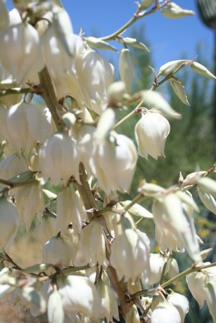
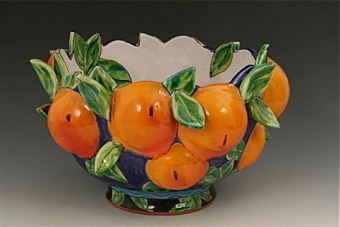
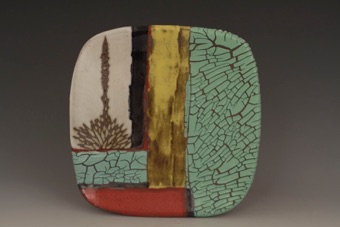
Farraday Newsome, Dark Blue Bowl with Oranges, 11 x 14 x 14”, glazed terra cotta
Jeff Reich, Monocarpic, 9 x 9 x 1.5”, glazed stoneware
1. Indigo Street Pottery Calendar
May 20 - October 3, 2010, Tohono Chul Park A- to-Z, Tohono Chul Park Gallery, Tucson, Arizona tohonochulpark.org
June 11 - August 8, 2010, Arizona Designer Craftsmen 50th Anniversary Exhibition, Mesa Contemporary Arts, Mesa Arts Center, Mesa, Arizona http://www.mesaartscenter.com/index.php/artexhibits/2010springexhibitions1
June 3 - August 14, 2010: A Midsummer Eve: An Exploration of Color and Surface, Meredith Gallery, Baltimore, Maryland www.meredithgallery.com
September-October 2010: Northern Clay Center’s 20th Anniversary Exhibition, with a collaborative piece by Jeff and Farraday, Northern Clay Center, Minneapolis, Minnesota http://www.northernclaycenter.org/see/exhibition_upcoming.php
October-November 2010: Narrative Animal Imagery, The San Luis Obispo Museum of Art, San Luis Obispo, California http://www.sloartcenter.org
-
2.Arizona Designer Craftsmen 50th Anniversary Exhibition, Mesa Contemporary Arts, Mesa Arizona
2010 marks the 50th anniversary of Arizona’s oldest professional studio crafts organization, Arizona Designer Craftsmen. This important milestone is being recognized with a major juried exhibition of its members’ work at Mesa Contemporary Arts at the Mesa Arts Center in Mesa, Arizona. The show runs from June 11 - August 8, 2010. Jeff and Farraday both have pieces in this highly anticipated show. The Mesa Arts Center is located on the southeast corner of Center and Main in downtown Mesa.
3. University Hospitals Group “Promise of the Garden” Commission
4. Jeff Reich and Farraday Newsome are now represented by Plinth Gallery of Denver, Colorado

We are very pleased to announce that we are both now represented by Plinth Gallery of Denver, Colorado! http://plinthgallery.com/ . Plinth represents a group of nationally recognized artists, with an emphasis on contemporary sculptural vessels. We’ll be showing our work there starting late this summer, and are scheduled to have a two-person exhibition in May 2012.
So what’s up this time of year in the native wildscaped part of our yard? What could possibly bloom and thrive in this relentless desert heat and sun? Well, with the help of our drip irrigation, we are enjoying the indigo flowers of Guayacan Guaiacum coulteri (left photo); the lush orange blooms of Tecoma stans “Jubilee” growing with purple flowering Solanum irishii and white-flowering flattop buckwheat Eriogonum fasciculatum (middle photo); and the fabulous flowerstalk of the Soaptree Yucca Yucca elata (right photo).
5. Indigo Street Pottery Wildlife Notes
It’s lizard season!! There is nothing quite as delightful as seeing the remarkably busy scurrying of the lizards in our yard this time of year. They live in a world of hunting for such tiny bugs that we humans must seem like a gargantuan race of Titans! Unseen and dormant all winter long, now the Desert Spiny Lizards and Western Whiptails are the reptile rulers of our yard.
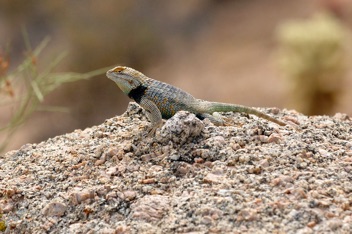
Desert Spiny Lizard (Sceloporus magister )

Western Whiptail: subspecies Sonoran Desert Whiptail (Aspidoscelis tigris punctilinealis, formerly Cnemidophorus t. p.)

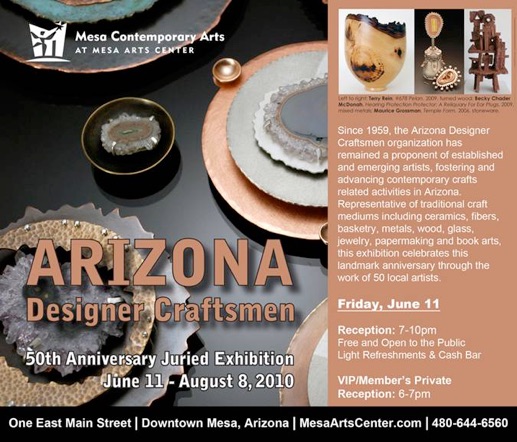



In these photos the work crew is attaching 1/2” chicken wire (AKA aviary wire) to the top of the garden structure to form a ceiling. The door is yet to be framed in. On the sides, you can see the first course of 1/2” hardware cloth already attached. This first course is attached to the perimeter underground concrete footer, so animals (in our case, squirrels and rabbits) can’t dig under. The rest of the sides will be covered in 1/2” chicken wire like on the top.
The compost area! To the right, Farraday is spinning the tumbler composter. Behind her is a stacker composter and a wooden pallet bin composter. We tarp the pallet compost bins when they are not in use to conserve moisture, which quickens decompostion. It has been great finding free sources of goat manure (Double Blessings Farm, a goat milk soap and lotion maker in Apache Junction http://www.dbgoatsmilk.com/ ), grass clippings (the friendly groundskeepers of the Mesa Arts Center), pine needles (wonderful friends with pine trees), free mulched/chipped landscape waste (King’s Tree Service), and spent coffee grounds (Starbucks has a green program called “Grounds for your Garden” where they bag spent coffee grounds daily to give away!)
Something on our minds now is learning more about our yard’s local soil. Our soil, like most desert soil, is lacking organic matter and is alkaline. However, our property’s soil does have good particle size - not too clay or sandy. We are fortunate. The compost we are making will help to neutralize the alkaline pH, something most of the vegetable and fruits we plan to grow will greatly appreciate. Here is an excerpt of a paper we read on the University of Arizona’ s Maricopa County Extension website about iron and soil fertility entitled “Recognizing and Treating iron Deficiency in the Home Garden”, by Dr. James Walworth, University of Arizona Associate Professor and Soil Specialist, 2006. ( http://cals.arizona.edu/pubs/garden/az1415.pdf from their website http://extension.arizona.edu/ )
Iron deficiency is a frequent problem...in the low desert areas of Arizona. The underlying cause for this malady is the high pH levels of our soils. Calcium carbonate (CaCO3) builds up in desert soils because precipitation is not sufficient to wash or leach these naturally occurring materials out of the soil...When calcium carbonate dissolves in water, it forms a solution with a pH slightly above 8, and this is the pH of many desert soils. In this high pH environment, iron solubility is minimized. In desert soils there is usually plenty of iron; it just is not soluble enough to provide adequate nutrition to certain plants. Iron deficiency can be worsened if calcareous soils are over-watered. If an adequate amount of iron is not available to plants, iron deficiency (iron chlorosis) will result...The symptoms of iron deficiency appear on the youngest, newest leaves. The area between the leaf veins becomes pale yellow or white (this is called interveinal chlorosis)...Susceptibility to iron deficiency varies greatly between plants. Desert plants are less susceptible to iron deficiency because they have mechanisms that enable them to solubilize and absorb iron from high pH soils. Plants from regions with acidic soils do not have this ability. Most humid tropical and subtropical regions fall into this category and therefore many of the ornamental and crop plants we have imported from these areas are susceptible to iron deficiency. Examples include citrus, rose, gardenia, crepe myrtle, and many others.
University of Arizona’s Arizona Cooperative Extension (College of Agriculture and Life Sciences)
The pine needles, citrus rinds, coffee grounds, mulched landscape waste, and goat manure are terrific acidic compost ingredients to help lower the soil pH. Compost in general tends to be acidic, which is great, and has the huge added benefit of improving soil structure to hold water better and provide a slow release of many, many nutrients the plants will need. Friends have been asking when will we plant, but right now our minds are happily focussed on composting and soil preparation. Although we really do look forward to planting, really!

8. Indigo Street Pottery Native Landscaping Notes


We were fortunate to meet Doug and Julie Jones this month and to visit their incredibly lush and intensively planted edible garden property in Mesa, Arizona. Doug is a co-founder of the Arizona chapter of the California Rare Fruit Growers organization (websites: http://www.azrfg.com and www.crfg.org). With over 700 fruit trees and a productive kitchen garden, this was an inspiring visit! In addition to the densely planted general acreage, the Jones have a very large greenhouse with innumerable tropical and subtropical fruiting trees, vines and shrubs. You need to duck and squirm to move through it! Doug, pocket knife in hand, gave us a very gracious, generous, delicious taste-testing tour. In the greenhouse we saw, smelled and/or tasted of variety of bananas, papayas, guavas, mangos, pitangas, avocados, dragonfruit, goji berries, and more. Outside, we pushed through densely planted, self-shading groves of apples, apricots, guavas, passionfruit, black raspberries, citrus of all kinds (including kumquats, oranges, grapefruits and pomelos - the grandparent of grapefruit), more avocados, and towering pecans casting shade from above. Chickens pecked about happily. The Jone’s have laid a very deep organic mulch of chipped tree trimming waste throughout the property. The mulch is over 12” deep, and if you dig into it and push it aside, it reveals a deep black humus layer resulting from years of this practice. The mulch, composting where it lays, supplies all needed fertilizer, and reduces the watering schedule to only once every two weeks in the summer. Doug told us that many tree-trimming businesses will deliver hills of this chipped/mulch “waste” that they create for free, keeping it out of the landfill.
7. Visiting the Tropical and Subtropical Orchards and Greenhouse of Doug and Julie Jones, Mesa, Arizona
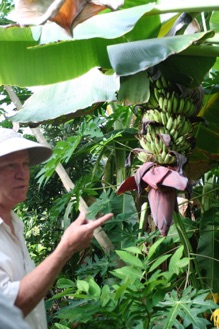






Here are photos of the Jones’ huge backyard greenhouse. It is a lush, healthy, dense paradise of numerous tropical and sub-tropical fruiting trees, shrubs, and vines. Above left: approaching the greenhouse, with a kitchen garden on the east side for afternoon sun relief. Above right: Inside the greenhouse, papaya fruits developing on the trunks of papaya trees. Bottom left and center: Jeff following Doug. Bottom right: Doug pointing out bananas with the purple male flower at the bottom. The male flower, which eventulally rots, is usually cut off so the fruit above will be spared the spreading rot and develop better.
Left photo: Jeff standing by large mounds of free chipped mulch “waste” delivered by a tree-trimming service. This is spread deeply and generously throughout the property.
Right photo: Throughout the property the more frost-tolerant fruit trees are planted outside with a beautiful, natural free-form density. There is no sense of rows or monoculture. It is all very lush, shady and texturally beautiful, providing a variety of fruit in all seasons.
Farraday is now glazing the six boxy wall tiles of Promise of the Garden, commissioned by Trudy Wiesenberger, Curator of Art at the University Hospital Health System in Cleveland, Ohio. This is for the University Hospital System’s new Cancer Hospital. The hospital, currently under construction, is set to open in early 2011. For more information, please read the story in our October 2009 Newsletter by clicking “Archived Newsletters” at the top of this page, and then clicking October 2009.









